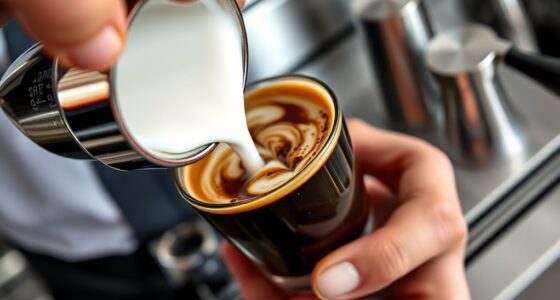The history of the cappuccino begins in Vienna’s coffeehouses, where baristas experimented with foam art and presentation, influenced by Central European customs. Over time, Italian cafés refined its recipe, emphasizing balance and visual appeal, shaping it into a symbol of Italian café culture. Today, the cappuccino’s popularity spans worldwide, showcasing creativity and artistry. If you’re curious about how this beloved beverage evolved across centuries and continents, there’s much more to discover.
Key Takeaways
- The cappuccino’s name originates from Capuchin monks, reflecting its historical roots and color scheme.
- Viennese coffeehouses played a crucial role in developing foam art and enhancing presentation techniques.
- Italian cafés refined the recipe, establishing the cappuccino as a symbol of sophisticated café culture.
- Modern cafés worldwide popularized latte art, elevating the drink’s artistic and cultural significance.
- The beverage now features varied flavors and designs, continuing its legacy of innovation and cultural exchange.

Have you ever wondered where the beloved cappuccino originated? The story begins in the heart of Europe, where coffee culture was evolving rapidly. The cappuccino’s roots are deeply intertwined with coffee artistry, a tradition that emphasizes not just the drink’s flavor but also its presentation. This artistry reflects a blend of cultural influences that shaped the beverage into what it is today. Originally, the name “cappuccino” comes from the Capuchin monks, whose brown robes resembled the drink’s color. This connection hints at the cultural influences that played a role in defining its identity. As coffee spread from the Ottoman Empire into Europe, it encountered various local customs, brewing techniques, and artistic styles. In Vienna, coffeehouses became hubs for intellectual conversation and social bonding, where baristas began experimenting with foam art and meticulous presentation, elevating coffee to an art form. Additionally, the Viennese coffeehouse tradition significantly contributed to shaping the cappuccino’s reputation. Here, the blend of cultural influences from Central Europe, Italy, and beyond fostered a unique environment for coffee innovation. The introduction of steamed milk and foam created a new layer of complexity, allowing baristas to develop intricate latte art that remains popular today. This artistic approach to coffee helped transform it from a simple beverage into a cultural experience, blending visual appeal with rich flavors. The spread of the cappuccino across Italy further refined its identity, with Italian cafés perfecting the balance between espresso, steamed milk, and foam. They also added a layer of sophistication, making it a symbol of Italian café culture. As the centuries passed, the cappuccino’s popularity grew globally, especially with the rise of modern cafés. Today, coffee artistry continues to thrive, with baristas worldwide competing to craft the most beautiful, innovative designs. The cultural influences that once shaped the drink’s development still influence how it’s prepared and enjoyed. From the traditional Italian cappuccino to modern variations featuring flavored syrups or latte art, the core concept remains rooted in its rich history. Whether you’re in a bustling city café or a cozy neighborhood spot, the cappuccino’s evolution reflects a fascinating blend of cultural influences and artistic mastery. Moreover, advances in brewing technology and materials have allowed for more creative and sustainable coffee presentation methods. So, next time you sip one, remember that you’re part of a centuries-old tradition that celebrates creativity, culture, and the universal love for coffee.
Frequently Asked Questions
How Did the Name “Cappuccino” Originate?
You might be surprised to learn that the name “cappuccino” comes from the Capuchin friars, whose brown robes resemble the coffee’s color. When you see coffee art atop your frothy drink, it’s a nod to the rich brewing techniques developed over time. The name stuck because the drink’s color and foam layer resemble the friars’ robes, making it a fitting and memorable term for this popular espresso-based beverage.
What Were the Early Variations of Cappuccino in Vienna?
Imagine stepping into a Viennese café and discovering early cappuccino variations, blending rich espresso with frothy milk, echoing centuries of Viennese coffee traditions. In the early days, baristas experimented with different ratios of espresso and milk, creating drinks resembling modern cappuccinos. These innovations reflected Vienna’s love for bold flavors and meticulous brewing techniques, laying the foundation for the cappuccino’s evolution from simple coffee to a beloved European staple.
Who Were the Key Innovators in Cappuccino’s Development?
You’ll find that key innovators in cappuccino’s development include baristas who perfected techniques like steaming milk to create rich, velvety foam. They experimented with coffee bean origins, sourcing beans that enhanced flavor and aroma, shaping the drink’s evolution. These pioneers combined skill and creativity, transforming the traditional espresso into the iconic, frothy beverage we enjoy today. Their innovations set the foundation for modern cappuccino craftsmanship worldwide.
How Did Cappuccino Become Popular Worldwide?
You see, cappuccino became popular worldwide because of its appealing coffee culture and iconic style. As espresso-based drinks gained popularity in Italy, travelers and cafes spread the beverage globally, especially during the modern café boom. Coffee chains adopted it, making it accessible everywhere. Its rich flavor and frothy top appeal to diverse tastes, helping cappuccino become a staple in global coffee culture and ensuring its widespread popularity today.
What Are the Traditional Ingredients Used Historically?
You’ll find that traditional cappuccinos use high-quality coffee beans, usually espresso, as the base. The key ingredient is milk froth, which is carefully steamed and textured to create a creamy, airy foam. Historically, you’d also add a small amount of sugar for sweetness. These ingredients come together to produce the classic cappuccino, balancing rich coffee flavor with smooth, velvety milk froth that’s instantly recognizable worldwide.
Conclusion
As you’ve seen, the cappuccino’s journey from Vienna’s cozy coffeehouses to today’s bustling cafes is like a rich, swirling brew of history and culture. Every sip carries centuries of tradition, blending Italian craftsmanship with modern flair. So, next time you enjoy your cup, remember you’re part of a timeless story that’s as warm and inviting as the foam atop your drink. Cheers to keeping this delicious history alive with every cappuccino you savor!









